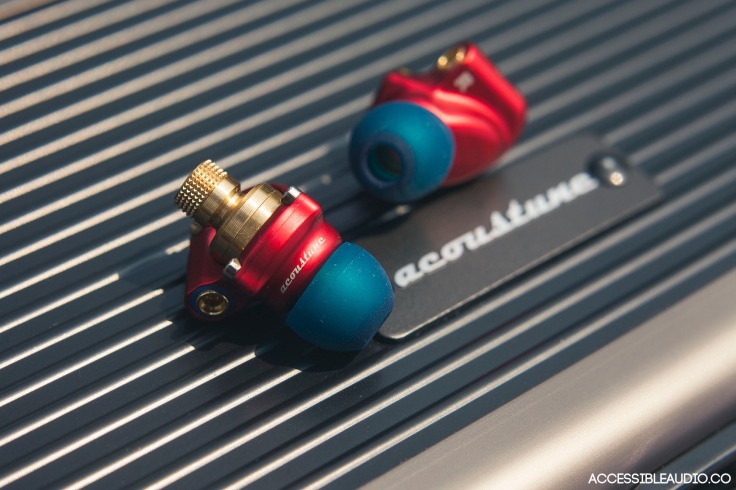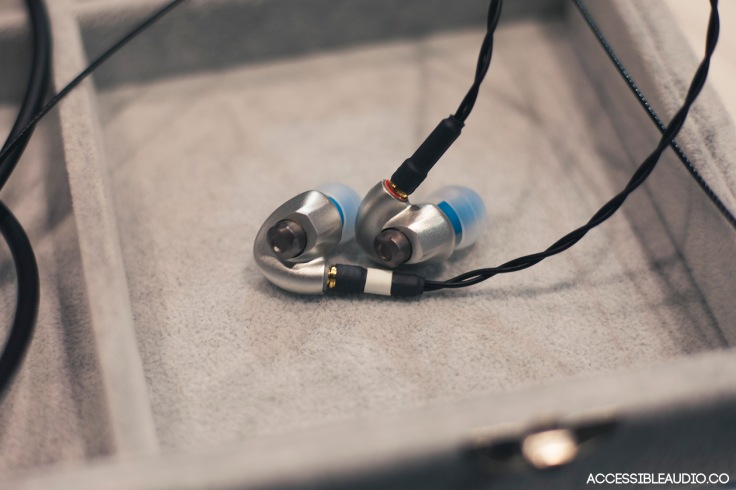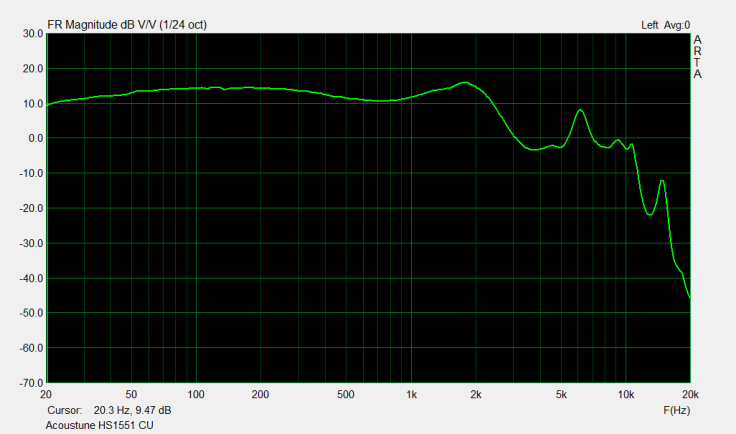I’ve been anticipating the release of the Acoustune HS1551 for ages, and now that I’ve finally gotten my hands on one, I’m happy to say that this is a
very refined single dynamic driver design, not only in terms of sounds but also looks and build quality.
I first encountered Acoustune in the Hong Kong High End AudioVisual Expo 2016 in the Soundwave Booth, when the Acoustune HS1551 was still a prototype known as the HS1301 (as far as I know). I had never heard of Acoustune before, but I was open to trying new IEMs, and although I only had a brief moment with them, they sounded
really good. Very satisfying bass coupled with non sibilant and extended highs, all coming out of a single dynamic driver. The metallic form also appealed to my tastes, and so ever since then I’ve been waiting for their final release, and I finally got a chance to try it
at this year’s Expo.
Acoustune’s HS1501/1551 prototype at the 2016 Hong Kong High End Audio Visual Expo.
I would like to thank Soundwave Hong Kong for lending us this demo unit of the Acoustune HS1551 CU for our review. We are not commercially affiliated in any way. The Acoustune HS1551 goes for $3980 HKD – around 500USD.
As far as I know, Acoustune is some sort of joint Hong Kong-Japanese partnership, and they’ve been around for at least a few years, developing several single dynamic driver designs. They pride themselves on using
Myrinx driver membranes in their drivers which they claim can provide the highest resolution audio (at least in earphones!). I’ve tried their HS1004 at HMV as well, and was also pleasantly surprised by it – quite a tight and spacious midbass sound with strong highs, but it was a little sibilant and unrefined at certain moments. However, I followed their posts on Twitter about the development of the new HS1551 and HS1501 series closely, and seeing how much attention to detail they put into it as well as the length of time taken, I knew it was going to be something good.
Note: The HA1551 CU is different to the HS1501 AL; don’t get confused by the confusing naming system.
Summary
For people who don’t want to read too much, here’s the verdict: The HS1551 CU is just
so warm, liquid, and comfortable sounding. But it’s not all about the bass here – there’s a smooth transition from bass to mids so vocals never disappear, and while the highs don’t take centre stage at all, they’re still extended and noticeable in the background. It’s got a fantastic design and build quality too.
Pros
- Luscious, warm, bass and mid frequencies give a comfortable fullness to bass and instrumental/vocal range
- Bass is solid but not overly aggressive; liquid sounding at times combined with the smooth midrange (but not so much that it’s loose and flabby)
- Very refined, extended highs twinkle in the background – not even a slither of sibilance here folks.
- Just so natural sounding, it really lets you focus on the emotional qualities of the music rather than the minor details.
Cons
- Bass could be slightly loose sounding for some discerning listeners
- If you want something brighter or more analytical, this probably won’t be for you. Go check out the Acoustune HS1551 AL or balanced armature options from other companies.
- Not the widest soundstage but it is very decent.
- I know some people hate memory wire, but since the cable did not have memory wire it did not always settle over my ears and I had to readjust the cable around them sometimes. At least the cable is replaceable!
Specs
Transducer: Φ10mm Single Dynamic Driver
Impedance: 32Ω
Sound Pressure Level: 110dB/mW
Frequency Range: 10Hz~25KHz
Cable: MMCX Re-cable, L=1.2m (4-core)
Plug: Φ3.5mm plug (gold plated), L-type
Shell: Chamber – 100% Brass CNC milling, Housing – 100% Aluminum CNC milling
Color: Grand Blue & Gold / Burgundy & Gold
Accessories: Earphone, Cable, Ear-tips (4 types)*, Earphone Case, Cable Clip & Tie, Warranty, Safety Instructions
* Ear-tips: AET02 (F), AET06 (M+), AET07 (S/M/L), AET08 (S/M/L)
Packaging & Accessories
The Acoustune HS1551 CU comes in a pretty hefty box. Removing the cardboard packaging and you’ll come face to face with a tiny metallic briefcase complete with sturdy set of hinges and a briefcase style latch. If you’re laughing at the slightly ridiculous size of the carry case and are wondering how anyone could carry this around, don’t worry because they’ve actually included a beautiful and much more portable leather carry case.
Regardless of the size though, it’s clear that they’ve paid lots of attention to giving the best first impression possible to the user, and it does give me that little bit of audiophile geek unboxing giddiness getting to open this elaborate packaging up to see the two shiny red and gold earphones nestled inside the foam container, just enticing me to take them out. Wrapped around the circular foam block is a 3.5mm braided, plastic sealed MMCX cable ready to be attached to the beautiful earphones.

Hidden underneath all of this is a large set of tips for your choosing with a variety of sizes and types including silicon and foam. I did not notice any huge differences between the yellow and blue centred tips, but you may want to try tip-rolling them.
Design
The Acoustune HS1551 CU is in my opinion one of the most attractive and unique IEM designs I’ve seen. The beautifully milled smooth aluminium shells combined with the more industrial looking brass “damper rod” (that’s what they called it on the packaging) that protrudes from the centre exudes a bold, futuristic appeal that you wouldn’t be surprised if it was one of Iron Man’s gadgets. Construction is rock solid and flawlessly put together – no rough edges to be seen anywhere, the parts are seamlessly combined and secured with 3 tiny hex screws.

While the form may seem odd and angled strangely at first, it actually is pretty straightforward once you take a closer look at it. Ignoring the more angular, detailed exterior, the HS1551 CU is actually very smoothly rounded on the ear facing side. In fact, there are no sharp edges to be found at all, with every corner finely chamfered and rounded for comfort. A clever design choice made by Acoustune is that unlike most dynamic driver designs which have the vent facing outwards, they hid the driver vent right next to the sound nozzle, significantly decreasing the chance of external noise from affecting it, and it does make for good amount of isolation.



If at this point you are still wondering how this odd looking IEM is worn, it’s actually a cable over ear design that will make all the sense once you try it on. Which brings me to my next point. The rather heavy stock cable has many things I love such as having a hefty L-plug, a thick, dual braided, plastic sealed cable which splits into two individual cables, all very sturdily built. I’m pretty sure that it’s going to be a long time before any of the strain points fail. The big, heavy set aesthetic of the cable does really match the bold, industrial design of the earphones but it does have some problems. It’s a little
too sturdily built in my opinion, as the stiffness of the cable sometimes causes a slight amount of microphonics when I’m moving around. Another point is that because there is no memory wire, the cables sometimes rebound from the position behind my ears and I’ve found myself occasionally having to adjust them back in place. Finally, the stiffness does lead to a bit of microphonic noise when using it on the go whenever the cable swings and comes into contact with anything. Maybe they should have used something slightly more delicate looking and softer. At least there is an option to replace it!
Sound
There’s just something about a good single dynamic driver design that sounds
so good. I started my audiophile journey as a diehard dynamic driver lover, discovered the possibilities of multidriver balanced armature designs, fell in love at the obvious strength of combining both types of drivers, but to this day I still have a huge fondness for single dynamic driver designs and in fact it has been growing with better and better dynamic drivers being implemented. Compared to multi driver balanced armature designs, single driver designs typically have the advantage of better, natural bass response and an unmatched sense of cohesion, but often suffer by the bass being too boomy and loose, less detailed mids and even sibilant, weak high frequencies but a high quality, well implemented dynamic driver can overcome all of those obstacles. Veterans like Sennheiser have never given up on dynamic drivers, while newer ones such as Campfire Audio are pushing the possibilities of driver design, and it seems like Acoustune is also keen on dedicating their craft into the perfection of single dynamic driver design, hitting a new sweet spot with the HS1551 CU.

Listening to the Acoustune HS1551 CU is just like that warm, comforting feeling when enjoying a nice cup of hot chocolate at home when it’s cold out. Like receiving a warm hug, the HS1551 CU gently but firmly pumps out an extremely smooth, natural bass response, the kind that only a dynamic driver can produce – full of air and with natural, robust impact. Every low frequency detail, from the lowest subbass rumble to the quicker strikes of the tom toms is reproduced with a warm clarity. Bass impact is
very controlled and actually quite gentle, with nary a sign of bass bleed, and just the slightest boost in quantity in the lower bass frequencies so that it’s still “musical” and “fun” sounding when it needs to bring out the big bass. There’s definitely enough bass quantity to enjoy heavier genres like rock and trance here, but it doesn’t have a very aggressive majorly boosted bass attack unlike something like the
Campfire Audio Vega, which hits
very hard.
The liquid warmth of the low frequencies persists all the way up to the midrange, producing rich, full bodied vocals and instruments. While the low and mid end of things is full of luscious warmth, the HS1551 CU is also superbly refined up top as well. Carrying just a tad bit of a bright edge and flavour to the vocals and highest details, the HS1551 CU adeptly adds these smooth final touches to its presentation making the music just that much more convincing. Highs are extended enough for those details to be obvious, but far, far away from any sense of sibilance. Listening to this IEM is an engaging but relaxed affair; a slight boost in the mid and high regions to pique your interest in the minutae of the singer’s voice, or the finely resolved pitter patter of the live audience’s clapping in the distance is what distinguishes it from weaker IEM designs. Apart from my own preference for warmer sound signatures, it’s this refined sound tuning that seals the deal for me.

The HS1551 CU is neither a reference nor a extremely “fun” hard hitting IEM, but it manages to straddle both of these extremes in its own way. The bass might be a little too warm or boomy for some, the midrange not analytical enough, or the highs not bright enough, but for those looking for an IEM that can just hit that sweet spot in the middle with magnificent mids, resolved highs, with a bit of oomph from the bass end, and let you listen to it for hours on end, the Acoustune HS1551 CU is the perfect choice.
Measurements
Notice the relatively flat 20-500Hz low end with a very gentle boost; followed by a small peak at 1-2kHz, this makes for a very lovely and rich low-mid frequency listening experience!
Comparisons
- Sennheiser IE80
As they are in a similar price range, I thought to compare it to the legendary IE80. Personally, I think the IE80 sounds a little flatter and more neutral, with less sparkly highs, and the low end also sounds a little darker as well. I prefer the Acoustune over the IE80, but if you want more aggressive bass impact and don’t really care for vocals or highs, the IE80 would be preferable. Otherwise, the Acoustune wins in all other aspects.
- Campfire Audio Lyra 2
I would say the Acoustune is a better value for money deal than the Lyra 2, but sonically, they are quite different. The Lyra 2 has a slightly more aggressive bass, and the rendition of details is more precise and fine, with slightly more high frequency detail. In contrast, the Acoustune has fuller vocals and is richer, but also more laidback. I really like them both!
Conclusion
I really like the Acoustune HS1551 CU. Sure, I have some complaints about the cable, but it’s got an amazing design, build quality, and most importantly, it’s just got a great sound signature. It ensures that none of the details are missing, but has that gentle boost on the low end to keep things fun. There are not many single dynamic driver IEMs out there that sound so refined. Definitely a recommended buy!
Reposted this on HeadFi for the lovely community!


































